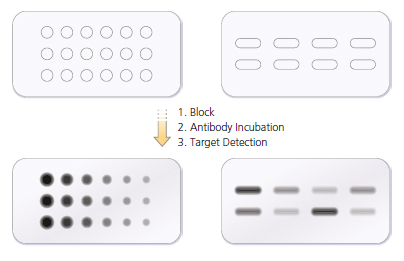Western Blot: Test Blots, Slot Blots, and Dot Blots

- On This Page
- Test Blots, Slot Blots, and Dot Blots
Overview
Test blots, as their name implies, are very simple Western blots that are created for the express purpose of optimizing or troubleshooting experimental conditions. They are usually produced by running multiple lanes of the same lysate or purified protein solution on a gel, and after transfer cutting the blot into strips to be tested individually.
They provide a quick and efficient means of examining a range of antibody dilutions or detection substrates
Dot blots and slot blots are also a very useful variation on the typical Western blot. They do not require gel electrophoresis, so there is no separation of proteins by size.
Instead, the target protein or cell lysate mixture is added directly onto the surface of the nitrocellulose or PVDF membrane. Protein solutions can be applied directly in a small volume, or with a vacuum manifold to produce an orderly grid of samples similar to that seen in Figure 14. Each dot or slot blot would contain known amounts of target protein or cell lysate.
Once dry, dot blots and slot blots are subjected to the same immunodetection steps used for Western blotting, i.e. blocking, antibody incubation, and target detection with substrate. Grey and black spots on the figure below indicate which samples are positive for the target protein and correspond roughly to the bands produced on a Western blot.

Figure 14: Dot Blots and Slot Blots. The dot blots at the left represent a dilution series of a sample, with smaller lighter dots corresponding to lower concentrations of target protein. The slot blots represent a group of random samples, the intensity of the signal corresponds to the concentration of the target protein in that sample.
By making a number of identical dots or slots of a single known protein sample, or a range of sample dilutions, one can quickly test several combinations and concentrations of primary and secondary antibodies. Dot blots and slot blots are also beneficial when screening a large number of samples, or if a simple answer will suffice.
The main downside to slot blots/dot blots is that they provide no information about molecular weight. Thus, it is harder to detect false positive signals, or to tell whether modified forms of a protein are present.
| Detection with Substrate | Chapter 4: Data Analysis |


